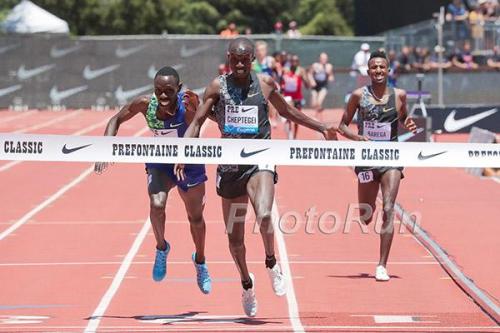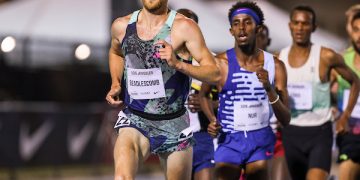The Nike Pre Classic is one of the best supported events in the world. Nike’s top athletes are there to both celebrate the sport and memory of the late Prefontaine, but to show the strength and support of Nike in global athletics.
Big changes afoot in athletics, and David Hunter writes about them below, in a thoughtful interview with Pre Meet Director, Tom Jordan.
RelatedPosts
This is David’s second piece on the 2019 Pre Classic and we thank him, once again, for his insights into the sport and the obvious love he has for global athletics.
 Tom Jordan, 2018 Pre Classic, photo by PhotoRun.net
Tom Jordan, 2018 Pre Classic, photo by PhotoRun.net
2019 Prefontaine Classic
Prefontaine’s Precise Presentation Previews Sport’s Future
Palo Alto, California
July 2nd, 2019
How many of you track & field fans relish the opportunity to get to the stadium for the 10:00 a.m. start of Day Two of the decathlon and stay engrossed in the day-long competition until the conclusion of the women’s 10,000 at 9:45 p.m.? I do see a fair number of you raising your hands. But for the less-rabid track & field fan, such a stint is not a dream come true. It is simply too much – too much for the more causal track & field fan, unappealing to the emerging generation of sports fans, and simply intolerable for any live television broadcast.
This understanding is at the foundation of a series the recent moves by the IAAF [now known as World Athletics] earlier this year to tailor the television broadcast segment – the TV window, if you will – for the 14 Diamond League gatherings in an effort to make track & field broadcasts tighter, with more uninterrupted excitement, and with more compelling competitions in the fast-paced world in which we live. The alteration is a step – one step among several – to constrain track & field broadcasts to a length that has proved to be acceptable to a vast number of viewers and to be relatively consistent with the length of other successful sport broadcasts [e.g. the length of an NBA game; the duration of an NFL contest; the coverage time of a MLB game (provided there are no rain delays!)]. Other Diamond League changes included a revamping of the number of DL events from 32 to 24 [12 per each gender] and a reduction of the longest running event distance from 5000 meters to 3000 meters.
The Prefontaine Classic – held this year at Stanford University while the new track & field facility in Eugene is in the midst of construction for next year’s season – assembled a schedule of events that featured 4 field events and 14 track events all of which were held and completed in a window of less than 2½ hours.
“The Diamond League is looking at changes,” candidly offered Prefontaine Classic Meet Director Tom Jordan after the Pre meet press conference. “One of them is to have the 3000 meters be the Diamond League distance, rather than the 5000.” But he quickly added, “That does not preclude any Diamond League meet from having a 5000. It’s just not a Diamond League 5000 meters [and can be added to the schedule outside of the TV window].” For example, we have 5 additional events in the schedule and one of them is the 1500 meters for women. The strength and depth of the field makes it one of the greatest fields ever assembled. So it’s not like it’s a second rate event.”
 Joshua Cheptegai takes the 2 mile! photo by PhotoRun.net
Joshua Cheptegai takes the 2 mile! photo by PhotoRun.net
Jordan laughed when asked about how he was able to insert a 2 mile event into the Prefontaine schedule when that event of approximately 3018 meters exceeds the new DL maximum track event distance. “The Europeans kind of scratched their heads and don’t quite get it. I’m not sure I do either anymore,” smiled Jordan. “The 2 mile run was Steve Prefontaine’s primary distance in high school. He was the American record holder in the distance. It seems kind of appropriate that the Prefontaine Classic would have a 2 mile event.” And Tom added an observation about the potential entertainment value of this rarely-run distance event. “It’s a little bit different in that if someone goes through the first mile in 4:03, [the fans] might be going, ‘Oh my gosh, look at that 4:03 and they’re still going.'” Jordan’s pre-meet speculation about the 2-mile race proved to be omniscient: as it turned out the following day, the 2-mile was quickly-paced and was capped by an electrifying finish as a furious final furlong by Uganda’s Joshua Cheptegei [8:07.54] caught Olympic medalist Paul Chelimo [8:07.59] right at the line for one of the narrowest wins of the meet. Athletes, fans in the stands, television viewers, and network top brass had to be smiling.
When the 45th edition of the Prefontaine Classic concluded in less than 2½ hours, a happy throng of 8,000 exiting Cobb Track and Angell Field chatted away about the exciting contests they had witnessed on the track and in the field. No one was heard to grumble, “Geez, I wish they had scheduled 4 or 5 more hours of competition.”
In the 21st century the battle among all sports for market share is more crowded than the bell lap of the 1500. And virtually all of the so-called Olympic sports – soccer, swimming, track & field, etc. – are reexamining the way they can restructure their presentation to become more attractive, to build their fan base, and to expand their viewing audience in the scrum for recognition and market share. The recently-emerging Diamond League model for the presentation of one-day world-class gatherings suggests our sport just might be on the right track. / Dave Hunter /
Author
Mark Winitz, long time scribe for California Track & Running News and American Track & Field, is a contributing writer on RunBlogRun.com.
View all posts




















